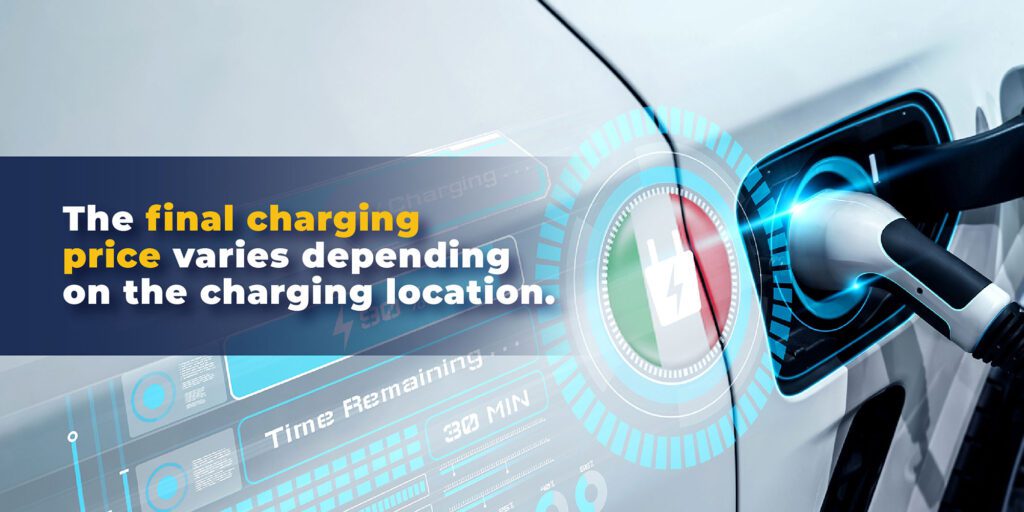EV charging prices in Europe are being shaped. For now, there’s no one-size-fits-all approach for establishing EV charging pricing. The private sector represents businesses with different business models, such as public charging networks, semi-private ones, home charging solutions, or a combination of all. Every provider now has the option to shape their pricing scheme.
However, the European Commission has embraced the Alternative Fuel Infrastructure Regulation (AFIR), promoting a shift towards an energy consumption-based pricing model. This move aims to unify charging pricing frameworks throughout the European Union, ensuring consistency and fairness in how EV charging is billed across member states.
Now, let’s discover the following:
- 6 Key Benchmarks that Shape EV Charging Cost in Europe Today
- The Shift Towards Dynamic Pricing
- Understanding The Role of Tariffs in Price Setting
- Regulations That Greenlight EV Charging Pricing Across Europe
- Pricing Framework for Electric Vehicle Charging For Certain EU Countries
- The Biggest Takeaway for Businesses with EV Charging Services
Pick the one that you’re most interested in, or keep on reading to get a full understanding of the whole EV charging pricing situation.
6 Key EV charging pricing models today

The following are the most common EV charging pricing strategies, each coming with its advantages:
Energy-based
This one is based on energy consumption and seems like the fairest and most transparent option for billing. It ensures that the price reflects the actual energy used, not the charging time.
It ‘makes even’ the two EV drivers, regardless of their vehicle models. Whether it takes 30 minutes or 2 hours to achieve the same kWh level of charge, both drivers will ultimately face the same cost for their charging sessions.
Fixed-rate
When a business launches a charging network or expands it, fixed pricing can seem attractive to undercut the competition. This way, the number of subscribers can increase, and existing customers will show more loyalty. However, such an approach is not for all. Drivers in transit will not appreciate it, which potentially discourages them from using the service.
Time-based
EV drivers are charged per minute they spend charging. This model for EV charging might not be fair since there are differences in EV’s battery size, architecture, and travel distance capabilities. As a result, it takes longer for certain EVs to consume the same quantity of electricity.
The time to charge an EV’s battery to 80% can vary from 20 to 50 minutes. Drivers of higher-performing EVs certainly benefit from this, especially when costs are calculated on a temporal basis. The nuances of vehicle charging efficiency and capacity differences are not factored in here.
Kilowatt-hour (kWh)
A single kilowatt-hour (kWh) represents the quantity of energy expended in one hour. Typically, travelling approximately 5 kilometres consumes about 1 kWh of energy.
Hybrid Pricing
This model for EV charging helps mitigate the problem of queues when EV drivers occupy charging spots long after their sessions have ended, preventing access for others awaiting their turn. It factors in both the duration of charging and the amount of kWh delivered.
Put simply, incorporating a time component alongside energy consumption makes charging stations more available for many as it helps avoid this whole vehicle’s post-charge situation.
Advanced pricing models
Off-peak and peak times can influence pricing as well. A pricing scheme that varies between peak and off-peak periods motivates EV owners to charge during less busy hours. Thus, they also benefit from reduced rates. This approach allows for preventing grid overload.
Charger speed can define the price. High-speed and super-speed DC charging services offer the benefits of rapid charging. These are often offered as premium offerings. Such charging options cost way more, which reflects their enhanced value.
EV charging pricing varies based on the type of EV service provider

Mobility Service Providers (MSPs) and Charge Point Operators (CPOs) factor in different aspects of their pricing. First, let’s make it clear with definitions.
The Electric Mobility Service Provider (or EMSP, MSP, or simply ‘provider’), is the entity that electric vehicle (EV) drivers engage with for all-around electric charging services.
The e-MSP is in charge of many things, incl., issuing charging passes, offering apps for finding and navigating to charging stations, overseeing and growing the roaming network, handling billing and invoicing, managing customer relationships, and setting prices for charging sessions for EV drivers.
These organisations shape EV charging pricing by also including charging card costs, their operational model, and service charges.
CPOs refer to a business or entity responsible for owning, running, and overseeing the infrastructure for electric vehicle (EV) charging. This includes both public and private charging points, along with the necessary hardware and software systems to manage them effectively.
Here, the pricing is shaped by factors such as pricing limits, costs of hardware, charging capacity, fees for network connectivity, power supply side, introductory rates, time-based tariffs, fees for occupying a charger beyond the necessary time, costs per kilowatt-hour, and fees for each charging session.
As you can see, EV charging pricing is so ‘nuanced’. Now, let’s proceed to dynamic pricing and why businesses turn to it as long as the market moves.
The shift towards dynamic pricing

The idea of transitioning to a dynamic pricing regime makes sense since some gasoline stations already offer it. This fundamentally comes down to the economics of the site that businesses have. But not only. It might include the electrical rate the business is on, the rate schedule, the demand side (even more than supply side), competition, and so on.
Other factors affect private EV charging pricing, like price herding behaviour. The topic is a subject of our profound explanation that we gladly share in another piece.
Understanding the role of tariffs in price setting

Tariffs and tariff categories determine pricing for EV charging at stations as well as dictate charging limitations and user access. The influence of tariffs on pricing can vary depending on several factors:
- The cost per kilowatt-hour (kWh).
- The charge per minute or other charging durations.
- The rate differences between day and night charging.
- Fees for parking minutes, including penalties for overstaying or idling when the vehicle is plugged in but not charging.
Charges are calculated based on the peak or average power usage during the session.
It’s crucial for tariffs to offer adaptability catering to different user groups, such as individuals, fleets, public users, or private entities, and to accommodate various locations, including homes, parking facilities, or buildings with multiple residential units.
The user’s status within the same locale or incentives such as complimentary or reduced-rate charging under specific scenarios make prices different as well. For instance, within a workplace parking area, the general public falls under a standard rate, while such particular groups as employees get a lower rate.
Regulations greenlighting EV charging pricing models across Europe

Germany has enacted legislation mandating specific standards for the measuring devices used in billing electric vehicle (EV) charging sessions. These devices are required to undergo regular calibration and must be visible to EV users. The law strictly forbids the use of measurement meters that fail to meet these calibration standards.
The law, known as Eichrecht, guarantees transparency for consumers, ensuring they are billed solely for the actual electricity (in kWh) they consume during charging. This measure prevents any unauthorized adjustments to the billing amount by Charge Point Operators (CPOs) or e-Mobility Service Providers (EMPs).
This approach not only secures the integrity and transparency of charging transactions but also sets a precedent that other nations are expected to follow in the pursuit of standardized practices.
The intricacies of electrical vehicle pricing models in EU countries

Establishing a unique pricing framework across the EU aims to enhance the charging process for electric vehicle (EV) drivers. However, the practice of displaying charging fees in real-time at or near the stations is not yet widespread.
Subscription to an e-Mobility Service Provider (EMP) influences the charging cost for an EV driver. Those who use the station without a subscription are subject to roaming charges.
Additionally, the cost of charging can fluctuate based on the electricity rates, which vary with the time of day and the specific electricity provider.
After selecting a pricing strategy for the charging stations, the next step is to incorporate this model into the right charging management system with a powerful billing system. It will allow for handling the automated processing of payments, the dispatch of invoices, and the management of VAT.
Pricing framework for EV charging for certain EU countries
EV charging in Europe is something super mainstream. Payments for the use of electric vehicle charging networks and the level and structure of price for electric vehicle charging are different. At MaxBill, we encourage you to learn in detail about the framework of electric car charge prices in the countries we list below. However, we gladly provide a short overview of the price setting for the European countries that we’re used to collaborating with. Take a look.
EV charging price in Germany

The concept of EV charging price in Germany is as follows: public electric vehicle (EV) charging stations are accessible with a charging card. A variety of providers offer it, each with different rates. By selecting two or three appropriate cards, EV owners can find cost-effective charging options.
Many providers now collaborate, forming networks that allow using a single card across multiple charging stations, enhancing convenience and accessibility. Although these cards are usually free, they may sometimes require a one-time activation fee.
These networked cards are beneficial for drivers who travel widely across Germany. They allow charging at stations from different operators, albeit at varying costs. Notably, some regions have formed consortia like ladenetz.de, further facilitating cross-provider charging.
EV pricing models and structures for charging vary. Some stations charge by the kilowatt-hour (kWh), similar to household electricity rates, ensuring affordable and quick charging. Alternatively, some operators offer a flat rate per charging session, with prices typically ranging between €5 and €10. This model simplifies costs but can vary in value based on the charging speed and amount of electricity required.
Overall, the EV charging infrastructure in Germany is characterised by its diverse range of providers, pricing models, and network collaborations, designed to cater to varied needs of EV drivers across the country.
EV charging prices in Italy

In Italy, the cost of charging electric vehicles (EVs) is largely influenced by the price of electricity. The electricity cost itself is a mix of market-driven raw material costs, system and network charges mandated by the regulatory agency, and additional taxes and VAT. The final charging price varies depending on the charging location:
- Charging at Private Premises: When charging within one’s own home, the cost is equivalent to the household electricity tariff, paid directly to the electricity provider under the existing contract. This offers a seamless integration of the EV charging cost into regular household utility expenses.
- Private Charging Stations: These are distinct from home charging setups and might include facilities like separate garages. Here, users are charged according to a special tariff for low-voltage consumers, established under a separate supply agreement specifically for that garage or charging installation.
- Public Charging: Public EV charging stations adhere to a tariff structure set by the regulatory authority. The providers of these charging services pay the tariffs to the utility company based on a supply contract specific to the provision of public charging.
It’s important to note that the costs associated with public charging are typically higher due to the added regulated components compared to private home charging where only the residential electricity rate applies.
EV charging prices in Norway and Sweden

Historically low and stable electricity prices have contributed to consistent charging costs for electric vehicle (EV) owners in Norway and Sweden. However, the landscape shifted in 2022 when electricity prices began to fluctuate significantly, presenting new challenges for charge point operators in setting and maintaining charging fees.
These operators now find themselves in a position where they must frequently adjust their EV charging pricing strategies in response to the dynamic electricity market and consumption trends.
It’s important to note that charging costs may vary depending on the method of access, such as different Radio-frequency identification (RFID) tags, charge cards, or app solutions, due to the open network policy of the charge point operators.
This means users may experience different pricing when using services from various providers, like Fortum and the Electric Vehicle Association’s charging club, as these service providers independently determine their pricing models and levels.
As a result of the escalating electricity costs, adjustments to the charging rates were implemented across Norway and Sweden starting from November 1, 2022.
In Sweden, the new pricing structure sets the cost for AC charging (up to 22 kW) at SEK 6.49 per kWh. For fast charging (up to 50 kW), the rate is SEK 7.99 per kWh, and ultrafast charging (up to 350 kW) is priced at SEK 8.49 per kWh.
In Norway, the revised rates for AC chargers (up to 22 kW) are now NOK 6.79 per kWh in the southern regions and NOK 4.29 per kWh in the northern areas.
Fast chargers (up to 50 kW) see prices set at NOK 8.49 per kWh in the South and NOK 6.49 per kWh in the North, while ultrafast chargers (up to 350 kW) are priced at NOK 8.99 per kWh in the South and NOK 6.99 per kWh in the North.
EV charging prices in France

A blend of factors is now influencing pricing for public electric vehicle (EV) charging in France. This includes charging power, subscriptions, and individual driving patterns. The structure of charging fees in France encompasses billing for energy consumption, time, and additional fees like session initiation or conclusion. Due to such a multifaceted approach, there was an uptick in overall charging costs, especially with ultra-fast charging stations, despite a drop in per kWh prices.
Now, it’s not about the electricity used. The French EV drivers can see an increase in ancillary fees, alongside the primary charging costs. This means a shift towards a more nuanced billing mechanism that takes into account various elements.
This complexity is further compounded by the evolving dynamics of the charging network, including the consolidation of regional operators and the revision of pricing models by Charge Point Operators (CPOs).
Under such conditions, EV drivers need to reconsider their usage behaviour, especially those without subscriptions. They need to be able to navigate the varied pricing models effectively and manage the cost implications of public charging.
EV charging pricing in the UK

The situation is pretty the same the EV charging pricing models. Some operators charge higher rates to recover the substantial costs of installing infrastructure. Despite fluctuations in commercial and wholesale energy rates, the fall in gas prices hasn’t led to a decrease in charging costs, suggesting a focus on recuperating initial investments.
However, Tesla stands out with its dynamic pricing strategy, offering peak and off-peak rates that often undercut those of major networks like Osprey or Gridserve thanks to their established infrastructure and recovered costs from earlier investments.
Tesla’s approach to building its charging network as part of its broader strategy to sell more cars has paid off, allowing it to offer competitive prices even as it continues to expand its network.
While there are still coverage gaps, especially in rural areas, Tesla’s pricing remains attractive compared to newer operators still in the early stages of investment recovery.
Despite this, there are clubs and subscription models available that can offer reduced rates, though Tesla generally remains the more affordable option, with location having a minimal impact on price.
Charging at home remains the most cost-effective option, with some tariffs offering rates as low as 3p per mile. The government’s push for more charging points in new homes, non-residential buildings, and renovations, along with grants and the rapid increase in public charging availability, underscores a commitment to supporting EV adoption.
The biggest takeaway for businesses with EV charging services

The landscape of EV charging pricing is dynamic and varied. This diversity reflects not just a response to the dynamic nature of the EV market but also a strategic approach to addressing the multifaceted demands of EV drivers and the operational realities of EV charging service providers. In this context, the necessity for a powerful and versatile billing system becomes clear.
Such a system must offer comprehensive capabilities to navigate and harmonise a broad spectrum of pricing models effectively. It should facilitate real-time adjustments to pricing based on a range of criteria (we’ve covered the majority of them).
For businesses, first and foremost, it’s about revenue sharing and reconciliation.
Therefore, for companies, using different pricing strategies at their stations, the billing approach should always comprise:
- Adaptability: aligning with the market and regulations
- Customer Segmentation: navigating between truck drivers and ladies in one-seat solos
- Transparency and Communication: bills can talk!
- Integration and Automation: integrations within charging management platforms and automating different procedures.
- Data Analysis and Reporting: assessing pricing strategies and adjusting offers
- Scalability: supporting the addition of new charging stations, services, and partnerships.
If you think your business model, which also includes EV charging services, lacks a robust billing system, let us know!
































